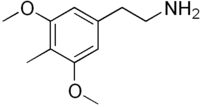DESOXY
| This article relies largely or entirely upon a single source. Relevant discussion may be found on the talk page. Please help improve this article by introducing citations to additional sources. (April 2015) |
 |
|
 |
|
| Names | |
|---|---|
| IUPAC name
2-(3,5-Dimethoxy-4-methyl-phenyl)-ethylamine
|
|
| Other names
3,5-Dimethoxy-4-methylphenethylamine
2-(3,5-Dimethoxy-4-methylphenyl)ethanamine |
|
| Identifiers | |
|
3D model (Jmol)
|
|
| ChemSpider |
|
|
|
|
|
| Properties | |
| C11H17NO2 | |
| Molar mass | 195.26 g/mol |
|
Except where otherwise noted, data are given for materials in their standard state (at 25 °C [77 °F], 100 kPa).
|
|
| Infobox references | |
4-Desoxymescaline, or 4-methyl-3,5-dimethoxyphenethylamine, is a mescaline analogue related to other psychedelic phenethylamines. It is commonly referred to as DESOXY. DESOXY was discovered by Alexander Shulgin and published in his book PiHKAL.
Effects[edit]
The effects of DESOXY vary significantly from mescaline, despite their chemical similarity.[citation needed]
Dosage[edit]
A typical dosage is within the range of 40–120 mg and lasts 6–8 hours.[1]
Legality[edit]
| This section does not cite any sources. Please help improve this section by adding citations to reliable sources. Unsourced material may be challenged and removed. (April 2015) (Learn how and when to remove this template message) |
In 1970 the Controlled Substances Act placed mescaline into Schedule I in the United States. It is similarly controlled in other nations. Depending on whether or not it is intended for human consumption, 4-desoxymescaline could be considered an analogue of mescaline, under the Federal Analogue Act and similar bills in other countries, making it illegal to manufacture, buy, possess, or distribute without a DEA or related license.
DESOXY is also an isomer of 2C-D which would cause it to fall within the definitions outlined by the Federal Analogue Act
References[edit]
- ^ Shulgin, Alexander; Ann Shulgin (September 1991). PiHKAL: A Chemical Love Story. Berkeley, California: Transform Press. ISBN 0-9630096-0-5. OCLC 25627628.
External links[edit]
- Alexander Shulgin, Jacob, P. Structure-Activity Relationships of the Classic Hallucinogens and Their Analogs. NIDA Research Monograph 146 (Hallucinogens: An Update), 1994.
|
|||||||||||||||||||||||||||||||||||||||||||||||||||||||||||||||||||||||
|
|||||||||||||||||||||||||||||||||||||||||||||||||||||||||||||||||||||||
|
|||||||||||||||||||||||||||||||||||||||||||||||||||||||||||||||||||||||
| Phenethylamines |
|
|---|---|
| Amphetamines |
|
| Phentermines |
|
| Cathinones |
|
| Phenylisobutylamines | |
| Phenylalkylpyrrolidines | |
| Catecholamines (and close relatives) |
|
| Miscellaneous |
|
|
Drugs from PiHKAL
|
|
|---|---|
|
- Articles needing additional references from April 2015
- All articles needing additional references
- Chemicals without a PubChem CID
- Articles without KEGG source
- Articles without UNII source
- Articles containing unverified chemical infoboxes
- All articles with unsourced statements
- Articles with unsourced statements from April 2015